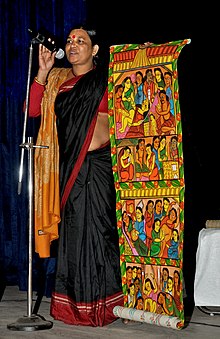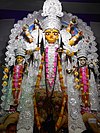
The music of West Bengal includes multiple indigenous musical genres such as Baul, Ramprasadi, Bishnupuri Classical, Kirtan, Shyama Sangeet, Rabindra Sangeet, Nazrul Geeti, Dwijendrageeti, Prabhat Samgiita, Agamani-Vijaya, Patua Sangeet, Gambhira, Bhatiali, Bhawaiya, Bengali Rock.

Birbhum district is an administrative unit in the Indian state of West Bengal. It is the northernmost district of Burdwan division—one of the five administrative divisions of West Bengal. The district headquarters is in Suri. Other important cities are Bolpur, Rampurhat and Sainthia. Jamtara, Dumka and Pakur districts of the state of Jharkhand lie at the western border of this district; the border in other directions is covered by the districts of Bardhaman of Purba Bardhaman, Paschim Bardhaman and Murshidabad of West Bengal.

Kalighat painting, Kalighat Patachitra, or Kalighat Pat is a style of Indian paintings which originated in the 19th century. It was first practiced by a group of specialized scroll painters known as the patuas in the vicinity of the Kalighat Kali Temple in Kolkata, in the present Indian state of West Bengal. Composed of bold outlines, vibrant colour tones, and minimal background details, these paintings and drawings were done on both hand-made and machine manufactured paper. The paintings depicted mythological stories, figures of Hindu gods and goddesses, as well as scenes from everyday life and society, thereby recording a socio-cultural landscape which was undergoing a series of transitions during the 19th and early 20th century, when the Kalighat pat reached its pinnacle.

Patachitra or Pattachitra is a general term for traditional, cloth-based scroll painting, based in the eastern Indian states of Odisha, West Bengal and parts of Bangladesh. Patachitra artform is known for its intricate details as well as mythological narratives and folktales inscribed in it. Pattachitra is one of the ancient artworks of Odisha, originally created for ritual use and as souvenirs for pilgrims to Puri, as well as other temples in Odisha. Patachitras are a component of an ancient Bengali narrative art, originally serving as a visual device during the performance of a song.

The Indian state of West Bengal is the site of India's first modern university. Thirty-three universities are listed in the state by the University Grants Commission.

The Indian state West Bengal has a rich cultural heritage. Due to the reign of many different rulers in the past, arts and crafts in West Bengal underwent many changes giving an artistic diversity today in the forms of traditional handicrafts, terracotta, painting and carving, dances and music.

The 2021 West Bengal Legislative Assembly election was the 17th quinquennial legislative election held in West Bengal, to elect all 294 members of West Bengal Legislative Assembly. This electoral process of 292 seats unfolded between 27 March to 29 April 2021, taking place in eight phases. Voting for the two remaining constituencies was delayed to 30 September 2021.








